Scott L. Smith Jr.'s Blog
October 15, 2025
Talking to Pentecostals About Trinitarian Baptism: Why Don't Pentecostals Believe in the Trinity and Baptizing in the Name of the Father, and of the Son, and of the Holy Spirit?
Let’s talk today about Pentecostals. How we can reach out to them when their Baptism is very different from Trinitarian Baptism. Why do Pentecostals believe that it’s okay to baptize in the Name of Jesus only?
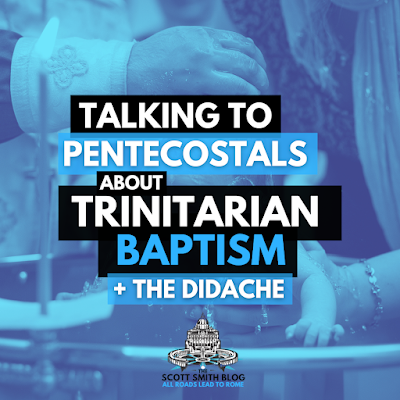
Watch the video here:
Jesus tells us clearly at Matthew 28:18-20 that we are to baptize in all three Names:
[18] And Jesus came and said to them, “All authority in heaven and on earth has been given to me. [19] Go therefore and make disciples of all nations, baptizing them in the name of the Father and of the Son and of the Holy Spirit [20] and teaching them to obey everything that I have commanded you. And remember, I am with you always, to the end of the age.”
These are the very last verses of Matthew’s Gospel. We have the words from Jesus Himself on how to baptize. Baptize in all three names. It’s straightforward. It’s simple. Where’s the confusion?
Baptize in the Name of Jesus Only?Jesus, in His own words, instituted all the sacraments. This is why Catholics and most other Christians stay very close to the words of institution that come from Christ himself.
We have the clear statement at Matthew 28:19. Later on in the Book of Acts, we see something different. Pentecostals typically reference Acts 2:38, which says the following:
Peter said to them, “Repent and be baptized every one of you in the name of Jesus Christ so that your sins may be forgiven, and you will receive the gift of the Holy Spirit.
First, note that these are St. Peter’s words, not Jesus’. It is strange that non-Catholics would attribute greater authority to the words of the first pope over Jesus.
But still, what does it mean to baptize “in the name of Jesus Christ”?
Most Christians believe that baptizing “in the name of Jesus Christ” is just an abbreviation of baptizing “in the name of the Father and of the Son and of the Holy Spirit.” This makes since, as we are first given the longer, then comes the shorter, abbreviated form. The Apostles did not yet have the word “Trinity,” so abbreviating this as “Trinitarian Baptism” would not be possible.
So What’s the Pentecostal Logic?Pentecostals typically argue that Jesus is giving us a “riddle” at the end of Matthew’s Gospel. Matthew is ending his Gospel with sort of a cliffhanger that will be sorted out when the Holy Spirit comes. The Holy Spirit does come at Acts 2:38, and St. Peter answers the riddle.
So what’s ? Jesus says “name” instead of “names” at Matthew 28:19. Jesus says baptize “them in the name of the Father and of the Son and of the Holy Spirit.” Why doesn’t Jesus say “names,” if we’re supposed to baptize in three names, not just one?
One quick answer to this is that “name” applies to all three “names”, because of the multiple use of “and.” Jesus doesn’t say baptize “them in the name of the Father, Son, and Holy Spirit.” Jesus draws it out. Jesus says baptize “them in the name of the Father and of the Son and of the Holy Spirit.”
For example, what if I said the following? Go kiss the forehead of your son and of your daughter and of your spouse. Would you assume I’m describing a three-headed person? No. You would assume three distinct person … a trinity of persons.
How Can We Definitively Resolve This Difference of Interpretation? What Did the Apostles Do?The Church has and always will provide the definitive interpretation of Scripture. That’s was Jesus’ point in establishing the Church and then sending the Holy Spirit to guide Her.
But what if we had an ancient document that showed how the original Apostles actually baptized people?
We do!
It’s called The Didache, or The Teachings of The Twelve Apostles.
The Didache or The Teachings of The Twelve ApostlesI was recently talking to some Pentecostal friends. I asked them a question. If we could provide you with a document that showed how the earliest Apostles treated Christ’s command, would you adopt Trinitarian Baptism … and possibly the Doctrine of the Trinity, as well? Pentecostals, by the way, don’t believe in the Trinity. Anti-Trinitarianism is ultimately what’s guiding their interpretation of Jesus’ clear statement (not riddle) on Trinitarian Baptism.
If I could get you a document from the 100s, from the first centuries, demonstrating that the Apostles used the Trinitarian formula, would that change your position?
This is exactly what The Didache does. That’s dee-dah-kay. It has a Greek origin similar to the word “didactic.”
This document is really helpful because it explains what the Apostles actually did in practice. It’s like an early Roman Missal or Mass rubrics for liturgies. It gives us a great insight into those early apostolic communities.
The Didache is not part of the Biblical Canon. If it were, we might not be having this discussion. It wasn’t included in the Biblical canon, because it’s like an instructional manual. It doesn’t match the other genres of the New Testament. It’s more like the Mishna or Midrash.
The Didache is well supported historically. Many of the Church Fathers actually cite to it. Early Christian figures like Clement of Alexandria (150-215), Origen (185-253), and Eusebius (260-339) cited the work, indicating it was known and valued in the earliest centuries of Christianity.
A 4th-century papyrus fragment was discovered among the Oxyrhynchus Papyri, and a 3rd-century Latin translation also exists, confirming its early circulation.
So The Didache has very strong historical credibility and provenance. You even have a lot of skeptics like Bart Ehrman recognizing the credibility and authority of The Didache.
What Does The Didache Say About Trinitarian Baptism?Here you go. This is Chapter 7 of The Didache, entitled “Concerning Baptism”:
And concerning baptism, baptize this way: Having first said all these things, baptize into the name of the Father, and of the Son, and of the Holy Spirit, in living water. But if you have not living water, baptize into other water; and if you can not in cold, in warm. But if you have not either, pour out water thrice upon the head into the name of Father and Son and Holy Spirit. But before the baptism let the baptizer fast, and the baptized, and whatever others can; but you shall order the baptized to fast one or two days before.
Here we have the Apostles clearing up any confusion by giving us the full Trinitarian formula.
AND giving it to us again. The Trinitarian formula is repeated twice.
Also note, there is no mention whatsoever of baptizing in the name of Jesus only. That’s not at all described. It’s like it never even occurred to the Apostles.
And again, from Matthew 28:19 to The Didache and for the next two thousand years, there is an unbroken Catholic tradition of baptizing in All Three Names, the Trinitarian Formula.
“Living Water”? There is a discussion of “living water” and what kind of water to baptize in. This is relevant to the arguments within Baptist circles about “full immersion” baptism, but not relevant to our discussion. Sufficeth to say, the top priority for baptism is having living water, like running water, like the River Jordan.
Fasting? “But before the baptism, let the baptizer fast and the baptized and whatever others can. But you shall order the baptized to fast one or two days before.” That’s interesting. Here we some evidence for an ancient tradition of fasting before major sacraments like Baptism. Catholics, for example, also fast before the Sacrament of the Eucharist.
Comments?I hope that was helpful to you. If you have any questions, please add them to the comments. Especially if there’s any Pentecostals listening, please help us to better understand your position. Let us know so we can have a full discussion.
Valid BaptismIt is important to note that if you want to come into the Catholic Church and you’ve only been baptized in the Name of Jesus, you will need to receive a valid Trinitarian Baptism. This is not “re-baptizing” — you can only be baptized once and forever.
It’s extremely important to help people understand the correct form for baptism, which is not just the Catholic Church, but all the Christian churches honor this. Baptism is the most important step in the Christian journey. It is our supreme protection against evil. It forgives Original Sin.
Please, let’s talk to our brethren, our Pentecostal brethren, our brothers and sisters in Christ, about this because we want them to have that beauty of the sacrament and that protection from evil. So please share this with a Pentecostal friend. Let’s keep the conversation going and I appreciate your time reading this.
May God bless us in the Name of the Father, and of the Son, and of the Holy Spirit!
Let’s talk today about Pentecostals. How we can reach out...
Let’s talk today about Pentecostals. How we can reach out to them when their Baptism is very different from Trinitarian Baptism. Why do Pentecostals believe that it’s okay to baptize in the Name of Jesus only?

Watch the video here:
Jesus tells us clearly at Matthew 28:18-20 that we are to baptize in all three Names:
[18] And Jesus came and said to them, “All authority in heaven and on earth has been given to me. [19] Go therefore and make disciples of all nations, baptizing them in the name of the Father and of the Son and of the Holy Spirit [20] and teaching them to obey everything that I have commanded you. And remember, I am with you always, to the end of the age.”
These are the very last verses of Matthew’s Gospel. We have the words from Jesus Himself on how to baptize. Baptize in all three names. It’s straightforward. It’s simple. Where’s the confusion?
Baptize in the Name of Jesus Only?Jesus, in His own words, instituted all the sacraments. This is why Catholics and most other Christians stay very close to the words of institution that come from Christ himself.
We have the clear statement at Matthew 28:19. Later on in the Book of Acts, we see something different. Pentecostals typically reference Acts 2:38, which says the following:
Peter said to them, “Repent and be baptized every one of you in the name of Jesus Christ so that your sins may be forgiven, and you will receive the gift of the Holy Spirit.
First, note that these are St. Peter’s words, not Jesus’. It is strange that non-Catholics would attribute greater authority to the words of the first pope over Jesus.
But still, what does it mean to baptize “in the name of Jesus Christ”?
Most Christians believe that baptizing “in the name of Jesus Christ” is just an abbreviation of baptizing “in the name of the Father and of the Son and of the Holy Spirit.” This makes since, as we are first given the longer, then comes the shorter, abbreviated form. The Apostles did not yet have the word “Trinity,” so abbreviating this as “Trinitarian Baptism” would not be possible.
So What’s the Pentecostal Logic?Pentecostals typically argue that Jesus is giving us a “riddle” at the end of Matthew’s Gospel. Matthew is ending his Gospel with sort of a cliffhanger that will be sorted out when the Holy Spirit comes. The Holy Spirit does come at Acts 2:38, and St. Peter answers the riddle.
So what’s ? Jesus says “name” instead of “names” at Matthew 28:19. Jesus says baptize “them in the name of the Father and of the Son and of the Holy Spirit.” Why doesn’t Jesus say “names,” if we’re supposed to baptize in three names, not just one?
One quick answer to this is that “name” applies to all three “names”, because of the multiple use of “and.” Jesus doesn’t say baptize “them in the name of the Father, Son, and Holy Spirit.” Jesus draws it out. Jesus says baptize “them in the name of the Father and of the Son and of the Holy Spirit.”
For example, what if I said the following? Go kiss the forehead of your son and of your daughter and of your spouse. Would you assume I’m describing a three-headed person? No. You would assume three distinct person … a trinity of persons.
How Can We Definitively Resolve This Difference of Interpretation? What Did the Apostles Do?The Church has and always will provide the definitive interpretation of Scripture. That’s was Jesus’ point in establishing the Church and then sending the Holy Spirit to guide Her.
But what if we had an ancient document that showed how the original Apostles actually baptized people?
We do!
It’s called The Didache, or The Teachings of The Twelve Apostles.
The Didache or The Teachings of The Twelve ApostlesI was recently talking to some Pentecostal friends. I asked them a question. If we could provide you with a document that showed how the earliest Apostles treated Christ’s command, would you adopt Trinitarian Baptism … and possibly the Doctrine of the Trinity, as well? Pentecostals, by the way, don’t believe in the Trinity. Anti-Trinitarianism is ultimately what’s guiding their interpretation of Jesus’ clear statement (not riddle) on Trinitarian Baptism.
If I could get you a document from the 100s, from the first centuries, demonstrating that the Apostles used the Trinitarian formula, would that change your position?
This is exactly what The Didache does. That’s dee-dah-kay. It has a Greek origin similar to the word “didactic.”
This document is really helpful because it explains what the Apostles actually did in practice. It’s like an early Roman Missal or Mass rubrics for liturgies. It gives us a great insight into those early apostolic communities.
The Didache is not part of the Biblical Canon. If it were, we might not be having this discussion. It wasn’t included in the Biblical canon, because it’s like an instructional manual. It doesn’t match the other genres of the New Testament. It’s more like the Mishna or Midrash.
The Didache is well supported historically. Many of the Church Fathers actually cite to it. Early Christian figures like Clement of Alexandria (150-215), Origen (185-253), and Eusebius (260-339) cited the work, indicating it was known and valued in the earliest centuries of Christianity.
A 4th-century papyrus fragment was discovered among the Oxyrhynchus Papyri, and a 3rd-century Latin translation also exists, confirming its early circulation.
So The Didache has very strong historical credibility and provenance. You even have a lot of skeptics like Bart Ehrman recognizing the credibility and authority of The Didache.
What Does The Didache Say About Trinitarian Baptism?Here you go. This is Chapter 7 of The Didache, entitled “Concerning Baptism”:
And concerning baptism, baptize this way: Having first said all these things, baptize into the name of the Father, and of the Son, and of the Holy Spirit, in living water. But if you have not living water, baptize into other water; and if you can not in cold, in warm. But if you have not either, pour out water thrice upon the head into the name of Father and Son and Holy Spirit. But before the baptism let the baptizer fast, and the baptized, and whatever others can; but you shall order the baptized to fast one or two days before.
Here we have the Apostles clearing up any confusion by giving us the full Trinitarian formula.
AND giving it to us again. The Trinitarian formula is repeated twice.
Also note, there is no mention whatsoever of baptizing in the name of Jesus only. That’s not at all described. It’s like it never even occurred to the Apostles.
And again, from Matthew 28:19 to The Didache and for the next two thousand years, there is an unbroken Catholic tradition of baptizing in All Three Names, the Trinitarian Formula.
“Living Water”? There is a discussion of “living water” and what kind of water to baptize in. This is relevant to the arguments within Baptist circles about “full immersion” baptism, but not relevant to our discussion. Sufficeth to say, the top priority for baptism is having living water, like running water, like the River Jordan.
Fasting? “But before the baptism, let the baptizer fast and the baptized and whatever others can. But you shall order the baptized to fast one or two days before.” That’s interesting. Here we some evidence for an ancient tradition of fasting before major sacraments like Baptism. Catholics, for example, also fast before the Sacrament of the Eucharist.
Comments?I hope that was helpful to you. If you have any questions, please add them to the comments. Especially if there’s any Pentecostals listening, please help us to better understand your position. Let us know so we can have a full discussion.
Valid BaptismIt is important to note that if you want to come into the Catholic Church and you’ve only been baptized in the Name of Jesus, you will need to receive a valid Trinitarian Baptism. This is not “re-baptizing” — you can only be baptized once and forever.
It’s extremely important to help people understand the correct form for baptism, which is not just the Catholic Church, but all the Christian churches honor this. Baptism is the most important step in the Christian journey. It is our supreme protection against evil. It forgives Original Sin.
Please, let’s talk to our brethren, our Pentecostal brethren, our brothers and sisters in Christ, about this because we want them to have that beauty of the sacrament and that protection from evil. So please share this with a Pentecostal friend. Let’s keep the conversation going and I appreciate your time reading this.
May God bless us in the Name of the Father, and of the Son, and of the Holy Spirit!
September 16, 2025
Today: First Time the Reigning English Monarch Attended a Catholic Mass Since English Reformation; The Most Recent in a Long Line of Historic Catholic Firsts in Anglican England
Are we witnessing the end of Anglicanism and the English Reformation-Revolution?
Picture yourself growing up in Anti-Catholic Protestant England. Here’s a selection of some of the cute nursery rhymes you might have hummed as a child:
Here comes the Pope, all dressed in white;
Kill him quick, or he’ll say Mass tonight.
– Cruel playground rhyme chanted by Protestant children in the 18th-19th century England
Or how about this little ditty?
Remember, remember, the Fifth of November,
Gunpowder, treason and plot.
I see no reason why gunpowder treason
Should ever be forgot.
… A rope, a rope, to hang the Pope,
A penn'orth of cheese to choke him,
A pint of beer to wash it down,
And a jolly good fire to burn him.
- From Guy Fawkes Day or the Gunpowder Plot of 1605, known as “The Bonfire Prayer”
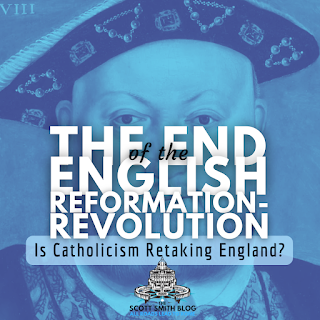
From these ashes, major Catholic trends are emerging in the United Kingdom. Is this a new Oxford Movement? A New English Renaissance?
Remember, remember, the 9th of April …
Remember, remember, the 7th of July …
Remember, remember, the 16th of September …
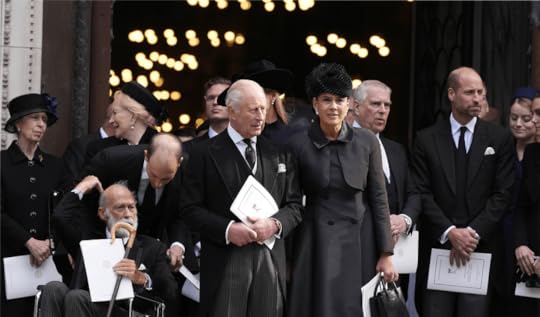
According to The Catholic Herald, the funeral of the Duchess of Kent marked the first royal Catholic funeral and the first time a reigning monarch has attended Catholic Mass on UK soil in a formal capacity since the Reformation.
The Prince and Princess of Wales joined the Duke of Kent and his three children for the Requiem Mass, the first Catholic funeral of a royal in modern times.
The music played at the funeral included Mozart’s Ave Verum Corpus, which was chosen by the duchess as her favorite hymn during her appearance on Desert Island Discs in 1990. Ironically, this meant the Anglican royal family was listening to "Hail, True Body", Mozart’s hymn about the Real Presence of Jesus in the Eucharist. Most Anglicans, given the Lutheran influence during the English Reformation-Revolution, only subscribe to a symbolic understanding of the Christ in the Eucharist.
July 7, 2025: First Mass Presided by Papal Nuncio at Canterbury Cathedral; Feast of Thomas a Becket
On July 7, 2025, the Holy Sacrifice of the Mass was celebrated at Canterbury Cathedral by the Papal Nuncio to Great Britain, Archbishop Miguel Maury Buendía. This was the first occasion in modern history that a papal nuncio presided over a Mass in the historic Anglican cathedral.
Catholic Masses have taken place in Canterbury Cathedral since the Reformation. Every year on July 7, for example, the Dean of Canterbury Cathedral allows the Catholic parish of St. Thomas of Canterbury to celebrate Mass in honor of St. Thomas Becket. Nevertheless, the involvement of the papal delegate is highly significant, given the historically “anti-papist” sentiment in England since the days of King Henry VIII.
The Mass celebrated the Feast of the Translation of St. Thomas Becket. The “translation” is the ceremonial transfer of Becket’s remains in 1220 from his original tomb in the crypt of Canterbury Cathedral to a grand shrine behind the high altar. This event occurred fifty years after his martyrdom and was attended by the teenage King Henry III, a host of European church leaders, and thousands of pilgrims.
April 9, 2025: Catholic Population Exceeds Anglicans, First Time
As of April 9, 2025, Catholics are on course to outnumber Anglicans in Great Britain. Younger churchgoers now outnumber their Anglican brethren by more than two to one, a report by the Bible Society reveals.
Executive summary from The Catholic Herald:
A “quiet revival” in UK Catholicism appears to be occurring, especially among those age groups referred to as Generation Z and younger Millennials, reports The Times of London, while noting that Catholics are rapidly catching up with Anglican numbers across all age groups.
It means that Catholicism could soon overtake Anglicanism to become the country’s largest denomination of worshippers for the first time since the English Reformation initiated by King Henry VIII in 1527. Anglicans could even slip into third place behind Pentecostals among churchgoers aged under 35 years of age.
Here are the numbers:1
According to the surveys, in 2018 Anglicans made up 30% of regular churchgoers aged between 18 and 34 – including all adult members of Generation Z and the youngest cohort of Millennials – while Catholics made up 22% and Pentecostals 10%. By 2024, Anglicans made up just 20% of this group while Catholics made up 41%. Pentecostals are now not far behind Anglicans at 18%.
In 2018 the survey found that across all ages, 41% of those who attend church at least once a month were Anglican, 23% were Catholic and 4% were Pentecostal. By 2024, the Anglican share had fallen to 34%, the Catholic share is “now close behind” at 31%, while the Pentecostal share has risen to 10%, the Bible Society report shows.
Figures collated by the Catholic Church in England and Wales also show a rise in attendance at Sunday mass since the pandemic, notes The Times, rising from 390,000 in 2021 to 555,000 in 2023, though they also indicate these are down from pre-pandemic figures of 702,000 in 2019. Catholics have already overtaken Protestants in Northern Ireland, data from the 2021 census shows.
Millennial or Gen Z? According to the Pew Research Center, anyone born between 1981 and 1996 is considered a Millennial, and anyone born from 1997 onward is part of the new generation termed Gen Z.
It’s not all good news. This is a period of rampant secularization across the UK: “Christians now make up the lowest ever proportion of the population, slipping below half for the first time in 2021 to 46.2 per cent, mainly driven by the growth in people with no religion, according to census figures.”
Any yet, the new report by the Bible Society suggests that the proportion of people in Britain attending church actually grew by more than half between 2018 and 2024. “The Quiet Revival” report also showed that men (13%) are more likely to attend church than women (10%), reversing the standard view of gender participation. Bible reading has also grown.
The relationship between the British Royal Family and the Roman Catholic Church has been shaped by centuries of history.
Glorious Revolution of 1688: King James II, the last Catholic monarch of Britain, is deposed and replaced by the Protestant William III and Mary II.
Act of Settlement 1701: Catholics barred from the line of succession, establishing a constitutional link between the monarchy and the Church of England that lasted for centuries. The Act of Settlement also barred members of the Royal Family from marrying Catholics under pain of exclusion from the line of succession. This and other measures effectively prevented the Royal Family from openly participating in Catholic rites or ceremonies for more than three centuries.
Succession to the Crown Act 2013: Eased some of the restrictions of the Act of Settlement, ending the disqualification of heirs who marry Catholics, though the monarch must remain Protestant. Allowed members of the Royal Family to engage with the Catholic Church more openly, without threatening the constitutional framework. Several royals have maintained private Catholic connections despite this historic barrier. For the Duke of Kent and other minor royals, practicing Catholicism has long been part of family life, even if rarely visible to the public.
1According to YouGov surveys commissioned by the Bible Society, which looked at more than 13,000 people in 2024 and 19,000 people in 2018, the growth in attendance has mainly been seen in Catholic and Pentecostal churches. The increase among younger people has been found especially with young men.
September 15, 2025
The Jewish "Our Lady of Sorrows": The Jews have been asking for the Intercession of this Mother for 3,000 Years
Happy Feast of Our Lady of Sorrows! “Happy” may seem a strange word to use, but that’s sort of the point …
Did you know the Jews also have an “Our Lady of Sorrows”? And knowing about her helps us better understand the Blessed Mother as “Our Lady of Sorrows”?

The prophecy that the Messiah will be born in Bethlehem connects the Blessed Mother to another mother, whose pregnancies were a contrast of health and sickness.
When the wise men came to King Herod, he assembled “all the chief priests and scribes of the people” and “he inquired of them where the Christ was to be born” (Matthew 2:4). They answered Herod, “In Bethlehem of Judea,” citing the prophecy of Micah:
But you, O Bethlehem Eph′rathah, who are little to be among the
clans of Judah, from you shall come forth for me one who is to be
ruler in Israel, whose origin is from of old, from ancient days …
until the time when she who is in travail has brought forth; then
the rest of his brethren shall return to the people of Israel
Matthew 2:5-6; Micah 5:2-3
Note that the prophecy states “Bethlehem Eph′rathah,” not just Bethlehem.
This is because the new matriarch of Israel is to give birth where the old matriarch of Israel gave birth and died. “She who is in travail” both points back to Rachel and forward to Mary.
According to Genesis, it was at Bethlehem-Eph′rathah, the place between the two cities, where Rachel and Jacob had to take shelter when Rachal suddenly went into “hard labor”:
Then they journeyed from Bethel; and when they were still some
distance from Ephrath, Rachel travailed, and she had hard labor.
And when she was in her hard labor, the midwife said to her, “Fear
not; for now you will have another son.” And as her soul was
departing (for she died), she called his name Ben-oni [meaning
“child of affliction” or “child of poverty”]; but his father called his
name Benjamin. So Rachel died, and she was buried on the way
to Ephrath (that is, Bethlehem), and Jacob set up a pillar upon
her grave; it is the pillar of Rachel’s tomb, which is there to this day.
Genesis 35:16-20
These two holy families, that of Mary and Rachel, are connected in so many ways.
Look at the name that Rachel originally chose for her son, Ben-oni, “child of affliction” or “child of poverty.” Though the health of Mary’s pregnancy contrasts with the sickness of Rachel’s, Rachel’s hard labor and death points to the poverty of the Holy Family, especially Jesus as the Suffering Servant, and Mary as “Our Lady of Sorrows.”1
Going back to the Gospel of Matthew, Rachel is mentioned again in reference to Herod’s response to the visit by the wise men, the Slaughter of the Innocents: “A voice was heard in Ramah, wailing and loud lamentation, Rachel weeping for her children” (Matthew 2:18).
Here is an ancient icon of Rachel weeping for her children:
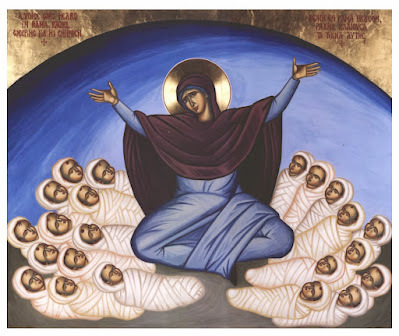
Ever since Jacob “set up a pillar upon her grave,” described above, the Jews have been visiting the tomb of Rachel, called “Kever Rachel” today. Just as we ask for the intercession of “Our Lady of Sorrows,” the Jews have been praying for their holy mother, Rachel, to intercede for them before the heavenly throne for 3,000 years!
The Jews even tell the story that, when the Babylonian army had conquered Israel and destroyed the Temple, as the Jewish survivors were being marched to Babylon in chains, they stopped to pray at Rachel’s grave.2 All the patriarchs appeared before God at this time to pray for God to forgive their children. Rachel found herself last in line behind Abraham, Isaac, Moses, and even her own husband, Jacob. God rejected all their prayers, but he could not refuse the tears of the mother.
Rachel prayed to God of her affliction. Because it was God’s Will, she allowed her sister to marry her beloved, Jacob. Now, she pleaded with God, saying “If I could give up my love for the sake of my sister, can’t you set aside your anger for the sake of your children?”
Because of Rachel’s plea, God allowed the Jews to return home to Israel.
Now, again, God has given us a still greater pair of intercessors, the Holy Spouses, the mother and father of Jesus, “Our Lady of Sorrows” and Our Prince of Sorrows, the “Patron of the Afflicted.”3 Go to them in good times and in bad, in riches and in poverty, and in health and in sickness.
1Isaiah 53:4,7: “Yet we esteemed him stricken, smitten by God, and afflicted … He was oppressed, and he was afflicted, yet he opened not his mouth; like a lamb that is led to the slaughter …”
2The Sefaria Midrash Rabbah (2022), Pesichta d’Eicha Rabbah (Lamentations 31:14-16), 24.
3June 5, 2025
Catholic Coffee Break Friday: Exciting Pope Leo news! Holy Family, Competitive Catechesis, St. Norbert, Pestering the Pope
It's Catholic Coffee Break Friday!
I recently published a new book on Near Death Experiences from a Catholic perspective, and I've been busy. I've never really one of my books explode like this before. It's been good, but a bit nuts.
I've got a big announcement. Check it out at the end. It's pretty exciting.
Also, Happy Feast of St. Norbert! More on him below ... Plus, the Solemnity of Pentecost is Sunday!
Here are the 5 or so coolest Catholic things I learned/enjoyed/discovered since our last coffee break ...
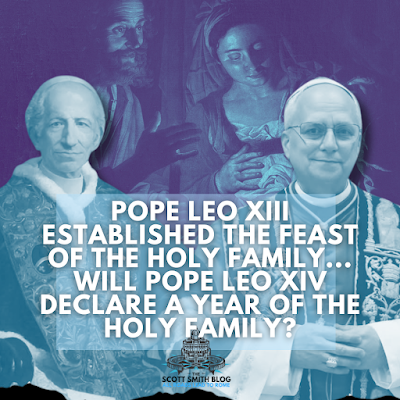
Table of Contents
1. Quotes I'm mulling over about obedience ...
I recently had an opportunity for obedience, which has never been an "easy" virtue for me. Here are some amazing quotes on holy obedience:
Obedience is a virtue of so excellent a nature, that Our Lord was pleased to mark its observance upon the whole course of His life; thus He often says, He did not come to do His Own will, but that of His Heavenly Father.
- St. Francis de Sales
A single instant passed under simple obedience is immeasurably more valuable in the sight of God than an entire day spent in the most sublime contemplation.
- St. Mary Magdalene de Pazzi
And again from St. Francis de Sales: “The Devil doesn’t fear austerity but holy obedience.”
I've also been assembling a Catholic Quote Index. It's called a quote rolodex, because it's organized by category.

2. Thing I've been pestering Pope Leo about ...
On June 14, 1892, Pope Leo XIII wrote an Apostolic letter on the Holy Family, Breve Neminem fugit, declaring the Feast of the Holy Family and elevating St. Joseph's feast day to a solemnity:
When God in his mercy determined to accomplish the work of man’s renewal, which same had so many long ages awaited, he appointed and ordained this work on such wise that its very beginning might shew to the world the august spectacle of a Family which was known to be divinely constituted; that therein all men might behold a perfect model, as well of domestic life as of every virtue and pattern of holiness: for such indeed was the Holy Family of Nazareth.
Now, it's time for Pope Leo XIV to pull a Pope Leo XIII and declare a Year of the Holy Family. Fr. Calloway and I are also about to publish 33 Days to the Holy Family, a consecration to the Holy Family. So, I'm writing the Holy Father weekly letters to ask him for this. I'm adding a little something extra to the letters, too. I'll tell you about that later and let you know how it goes :)
Feel free to share and post the image below:

It seems like Pope Leo is very close to declaring a year of the Holy Family. This past Sunday, the pope gave the following homily for the Jubilee of Families 😄, Children, Grandparents, and the Elderly on St. Peter’s Square at the Vatican (read the full transcript here):
Dear friends, if we love one another in this way, grounded in Christ, who is “the Alpha and the Omega,” “the beginning and the end” (cf. Rev 22:13), we will be a sign of peace for everyone, in society and the world. Let us not forget: families are the cradle of the future of humanity.
In recent decades, we have received a sign that fills us with joy but also makes us think. It is the fact that several spouses have been beatified and canonized, not separately, but as married couples. I think of Louis and Zélie Martin, the parents of Saint Therese of the Child Jesus; and of Blessed Luigi and Maria Beltrame Quattrocchi, who raised a family in Rome in the last century. And let us not forget the Ulma family from Poland: parents and children, united in love and martyrdom. I said that this is a sign that makes us think. By pointing to them as exemplary witnesses of married life, the Church tells us that today’s world needs the marriage covenant in order to know and accept God’s love and to defeat, thanks to its unifying and reconciling power, the forces that break down relationships and societies.
For this reason, with a heart filled with gratitude and hope, I would remind all married couples that marriage is not an ideal but the measure of true love between a man and a woman: a love that is total, faithful and fruitful (cf. SAINT PAUL VI, Humanae Vitae, 9). This love makes you one flesh and enables you, in the image of God, to bestow the gift of life.
What other "exemplary witnesses of married life" could we point to? The Holy Family is coming ...
New Advent Catholic Encyclopedia - I'm sure you all have used this before. It has a huge number of in-depth entries. It also has the entire Summa Theologiae, completely searchable. I've been using this resource a lot recently, because I have a big, new writing project (yes, another project).
I got an idea 10 years ago, and I've been plugging away at it steadily ever since. Well, it's more like I've been hitting my head against a wall for 10 years. Until last week!
This project is called Catholic Quiz Bowl or "The Bishop's Cup". It's about competitive, intellectual formation for high school and middle school. I played A LOT of quiz bowl growing up and even into college. I've written for all the different question companies, even Jeopardy! I was even on Who Wants to Be a Millionaire? But, I began to notice over the years how woke the questions had become. In the quiz bowl world, there's even a canon of acceptable or ask-able questions -- it is not a Catholic canon. I'm going to change this.
My own diocese is finally hosting the first Bishop's Cup this year! In the next years, we are inviting other dioceses to join us. Each diocese will then bring its champions to the National Catholic Quiz Bowl Tournament. We will probably host this at EWTN headquarters, so the tournament can be televised. Exciting stuff! Stay tuned ...
St. Norbert inspires me to be better about praying the Divine Office! Pre-conversion, St. Norbert wasn't exactly what you would call "pious." He was a kind of ordained man called a canon, like a sub-deacon. As a canon, he received a salary for just praying the Divine Office each day. He found a way to outsource this and increase his income! He paid someone to take his place praying the Divine Office each day and moved to the court of the Prince-Archbishop of Cologne. He quickly advanced and became a member of the court of Holy Roman Emperor Henry V, where he was put in charge of distributing the royal alms. Does this remind you of Judas? That was the path he was heading down, until ...
He was literally struck by lightning! And, he had a near-death experience!
Want to read more? Here's a really good write-up about St. Norbert.
Hope you enjoyed all that! Please drop me a line and let me know if anything moved you. Thanks for all your emails so far!
In Christ through Mary & Joseph,
Scott
⏬⏬🤯😁👍⏬⏬
P.S. I've been working as a producer on another secret project that's about ready for launch. It's about Venerable Aloysius Schwartz, the founder of the World Villages for Children. Here's the link to the preview. Very excited to share this one with you!

May 12, 2025
Pope Leo XIV's Louisiana Roots: A Spanish Colonial Governor and Military Commandant, Carlos Louis Boucher De Grand Pré
By Brian J. Costello
Pointe Coupéeans joyous over in the election of the first pope from the United States and only the second from the Western Hemisphere can be especially jubilant in that Robert Francis Prevost, now His Holiness Leo XIV, has roots in this parish. In his maternal lineage, he is descended from a number of early Louisiana Créole families, including Glapion from New Orleans, Lemelle from the Opelousas country, and GrandPré from Pointe Coupée.[1]
The Holy Father’s great-great-great-grandfather Louis Charles Boucher de GrandPré (1745 – 1809) - here pictured - was commandant of the military post of Pointe Coupée during the Spanish colonial period, from 1776 until 1781. Early in his administration, authorities built a camino real (royal road) linking the Mississippi River to the north with False River on the south, which the French populace dubbed the Chemin Neuf (New Road) for which the city is named.
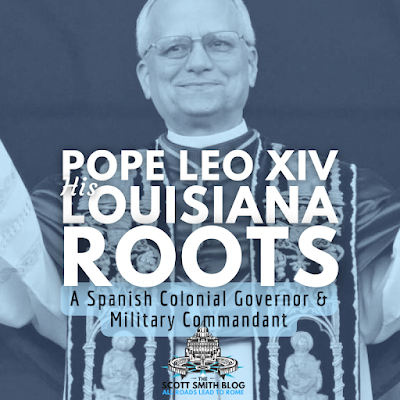
Shortly thereafter, GrandPré led the Pointe Coupée Militia in successful repulses of British forces at nearby Thompson Creek, the Amite River, and Baton Rouge in Spain’s collaboration with the American colonists in their fight for freedom from Great Britain. Countless residents have since qualified for membership in the Sons and Daughters of the American Revolution owing to their ancestors’ military service.
GrandPré's memory is preserved in the name of a street in Baton Rouge’s early Beauregard Town neighborhood. While few landmarks survive from the era of GrandPré, the continuity of the Catholic faith since the time of the Spanish and French explorers of the 18th century is the lasting legacy of colonization and evangelization in Pointe Coupée and Louisiana.
People of color and marginalized white families persisted in and promoted the faith through centuries of socio-economic oppression and natural disasters including the atrocities of enslavement and postbellum lynching, and the diaspora of family and friends during the deadly flood of 1912.
The pope’s family was among those who left the South for more educational and economic opportunities, and His Holiness is a native of Chicago. His paternal line, Prevost, might have another genealogical link with Pointe Coupée, alas back in Europe, as the matriarch of the early Jewish merchant Jewell family was the legendary Sophie Prevost, a Catholic émigré of the Ste. Domingue (Haitian) revolution. Additionally, Prevost is a prevalent surname in many South Louisiana communities.
Addressing the suffering that continues to oppress countless people, of various ethnicities, Cardinal Prevost in the late 20th and early 21st centuries was a vanguard in the struggle for social justice and workers’ rights, particularly in Peru where he ministered for approximately two decades.
Cardinal Prevost’s profession in a religious order and selection of Leo as his regnal name also has especial local effect, as the most beloved pontiffs here in earlier generations were Leo XIII and Gregory XVI. Born Gioacchino Vincenzo Raffaele Luigi Pecci, the frail but dynamic Leo XIII prefigured Prevost’s campaign for social justice and the dignity of laborers, delivered a dozen encyclicals on the Rosary devotion, and composed the Prayer to St. Michael the Archangel. Many were the Pointe Coupée faithful of the time who named their children Léo, Léonida, Léonide or Léonie in honor of the little pope who was big on liberation and empowerment of the working masses.
The new pontiff is one of but few in recent centuries to have been a member of a religious order, Leo XIV being an Augustinian. Recently-deceased Pope Francis, birth name Jorge Mario Bergolio, was a Jesuit, and Gregory XVI, was a professed Camaldolese. Gregory, born Bartolomeo Alberto Cappellari, in 1839 issued the bull In supremo apostalatus condemning the slave trade and was, doubtless, a model for Pointe Coupée emancipationists including the venerated Madeleine Olivo, widow of Simon Porche.
Pointe Coupée Parish oral historians and raconteurs have long quipped that the community was home to a native born pope: “Pope” Gebhart, of German and local French ancestry. False River Road farmer Francois Olivier Gebhart (1886 – 1945) was affectionately known to generations by the ti’ nom or nickname “Pope.” His wife, née Marie Anita Bergeron, was similarly beloved by the sobriquet “Madame Pope,” and a stalwart member of St. Mary of False River. In standard French, however, the term for the supreme pontiff is pape.
[1] Archdiocese of New Orleans and Diocese of Lafayette sacramental records; conveyance records of Pointe Coupee Parish; and United States Federal Census Schedules.
May 8, 2025
Catholic Guide to the Holy Oils: What does OC, OS, OI, and SC all mean? What are Sacred Chrism, Oil of Catechumens, and the Oil of the Infirm used for?
If you're an altar server or sacristan -- or even a deacon of priest -- the various oils may still be confusing. I know it's been a tough one for me.

Here's the breakdown:Sacred ChrismSC for Sanctum Chrisma Sacraments: used for the Sacrament of Confirmation and Baptism Ingredients: made from olive oil and balsam Oil of CatechumensOC for Oleum Catechumenorum, also OS for Oleum Sanctum, also "Oil of Exorcism" - at our Church, I'm pretty sure the canister says OC and the cruet says OS, so heads up! Sacraments: only used for the pre-Baptized, the pre-Baptized are called "catechumens" (pl. catechumenate)Ingredients: made from olive oil only Oil of the SickOI for Oleum Infirmorum, also called Oil of Healing Sacrament: used in the Anointing of SickIngredients: made from olive oil only
Does this help? Does this resolve all the confusion? Please let me know if you have any more questions!
January 29, 2025
Big Catholic Family Pilgrimage Travel Tips: Our Lady of Guadalupe and Chalco (Sisters of Mary, World Villages, Girlstown)
We have a big Catholic family. We have 6 kids (so far), so there are 8 of us, and 2 in diapers. We are well-traveled domestically. We've made at least one US national parks trip plus pilgrimage every year for the last decade. I'm decently well-traveled, having made pilgrimages in Europe and a mission trip to Kenya. My wife is a little fresher to international travel.
So we're making a bit of a leap of faith! If this pilgrimage goes well, we hope to make a long European pilgrimage next year with a bit of Catholic world-schooling/homeschooling: Catholic world-homeschooling. Can somebody coin a better term, please?
The following will be a bit of a travelogue (to be updated as we go) and a bit of a travel tips guide. Please let me know (comment below) your own travel trips and/or thoughts/improvements on my choices! ... Stay tuned for updates :)

Big Catholic Family Pilgrimage - Table of Contents Table of Contents
#1 Drive to a Major Airport, then Fly Out With a big Catholic family -- I find -- it's much less expensive to drive the distance to a major airport, then fly out. For Europe, I would drive my family to Atlanta, NYC, etc. For Mexico, we're driving to Houston. This cuts off half the price, right off the bat. Parking and even a night or two at a hotel don't come close to wiping out the savings. This just becomes another fun part of the trip.
#2 Accumulate Travel Miles when paying bills, major purchases, etc.I have a business with a lot of monthly, money in, money out, expenses. I use a travel miles credit card for these and rack up a huge amount of miles. Don't feel bad about profiting from a credit card company, IF you can do so while still paying off the card every month. OR, if you have a major expense and cash ready to pay it off, like a home remodel, put it on the credit card, then pay it right off.
Big Catholic Family Pilgrimage Travel Tips: Getting 8 Passports8 new passports (mine and my wife's had expired) ran us over $1200. Yikes! Be prepared for this expense.
Pro-tip: Have all paperwork filled out and ready before you get to the post office. We just happened to have a friend in our local post office, who enjoyed the one-hour steady stream of kids. You may not be so lucky! My wife worked on the paperwork in the van, while I transported kids in and out. Teamwork makes the dream work!
Big Catholic Family Pilgrimage Travel Tips: How to Store 8 Passports on My Body?Jacket with lots of pockets or fanny pack? I decided to go with ...
Catholic Pilgrimage Outerwear: Making Your Clothes Your Carry-On AND Carry-All
Meet the SCOTTeVEST Tropiformer 3D Jacket for Men. It has 22 Hidden Pockets! My goal is for this to be my carry-on AND carry-all for all 8 passports and everything else my big family will need on our excursions. Basically, I'm trying to be the dad Swiss-army knife.
This will be my most expensive travel purchase, apart from all the tickets, passports, etc. I'll let you know if it was worth it!

Post-Pilgrimage Assessment: STAY TUNED ...
Big Catholic Family Pilgrimage Travel Tips: Using Carry-On Bags OnlyHere's our plan to use ONLY carry-on bags for our big family pilgrimage. We have one infant, so we can carry-on as many as 7 total bags. We're not counting on the youngest kids to carry much; we're just counting on their carry-on allotments.
Here's our plan for carry-ons bags:2 rolling duffle bags 2 duffle bags strapped onto the roller duffle bags (above)1 backpack dufflePlus, 1 stroller checked in and out at the gate >> This doesn't count towards our tally. The airlines provide this as a service.
Here's our plan for who carries which bags:
My wife and I: 4 bags, we'll each have a roller with a duffle strapped on Oldest girl: carries infant in armsOldest boy: pushes stroller with toddlerOlder boy: backpack duffle (or hang on stroller)With this arrangement, we still have two carry-on slots not being used! We're packing some of the extra Gonex duffle bags, just in case we need more room. We found some really inexpensive (gulp) duffle luggage on Amazon. We also decided on distinct colors to make sure we don't get out luggage confused with that of other folks.
We bought 6 bags for under $200. We bought 3 of each of the following (an extra of each):
$29 Gonex Duffle Bag, 40L,dimensions: 20.8 x 13 x 9.8 inches (well within limits),
basically folds down to the size of a ketchup packet LOL

$29 Rockland Rolling Duffel Bag, 40L,
dimensions: 22 x 12.5 x 11 inches (well within limits)

Regarding the carry-on dimensions, I found this tip on Reddit from a guy who took the time to measure the sizing bins:
The limit is officially 22" x 14" x 9". The sizer is actually (roughly) 23" x 15" x 10" to avoid arguments. Any suitcase less than 23" x 15" x 10" will fit the sizer. Even an in inch or so beyond that is fine although technically oversized. The GA are really just looking for comically oversized bags or people with multiple suitcases.
Post-Pilgrimage Assessment: STAY TUNED ...
Big Catholic Family Pilgrimage Travel Tips: What to Wear?
My boys and I like to altar serve together, especially at pilgrimage sites. Here's my big hairy audacious goal (BHAG). My goal is to have one set of clothes that I can wear everyday (except for undies) that's comfortable and appropriate for all the following:
TravelingHiking up TepeyacUrban walking tripsChasing after kidsPlaying sports with the ladies and sisters of Girlstown (this may be the most impossible of all the goals, LOL)AND altar-serving or attending Holy MassCatholic Pilgrimage Footwear
I'm going with Vans High Top Sneakers. This is not because I'm trying to be a cool dad. I'm going with these for a mixture of ankle support, being all black, relatively cheap, and good for all the above.

Post-Pilgrimage Assessment: STAY TUNED ...
I've also been loving these Merino wool socks I found on Amazon. These have been great for altar-serving, too.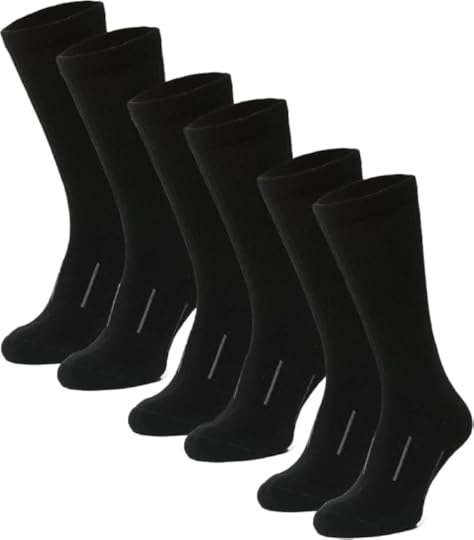
Post-Pilgrimage Assessment: STAY TUNED ...
Catholic Pilgrimage Pants
I wanted to get these pants, the Proof 72-Hour Merino pants from Huckberry, but decided to save money and use what I already have. Gear Junkies rated these really high, and I like a Merino option. That thousand-pocket jacket should cover my needs here.

Big Catholic Family Pilgrimage Travel Tips: Computers and Tech?I've got an Android phone, because I use a lot of Google apps for writing, email, etc. We'll be using WhatsApp to keep in touch with the homefront.
Do I Need a Power Adapter for Mexico?I'm told I will not need a power adapter for Mexico ... gulp.
Post-Pilgrimage Assessment: STAY TUNED ...
Catholic Pilgrimage ComputerThis should not be a major writing trip for me. Otherwise, I would probably bring my normal laptop. Instead, I'm going to try using an iClever bluetooth foldable keyboard:

Post-Pilgrimage Assessment: STAY TUNED ...
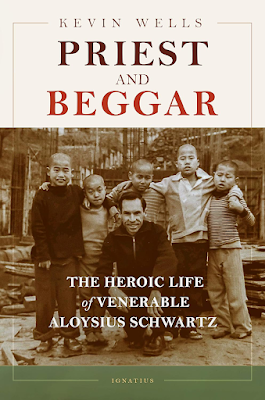
What a great book! This one of the only books that I've read in the last two or so years that I could not put down. Do yourself a favor and read it. Kevin Wells is the latest in that long line of great, former Baseball journalists-turned-writers.
Also, this is my favorite Our Lady of Guadalupe-specific books: The Story of Guadalupe: Luis Laso de la Vega's Huei tlamahuiçoltica of 1649 :

This is a translation of our oldest extant document about the apparitions of Our Lady to St. Juan Diego and Juan Bernadino. This is where we get the words we have from Our Lady of Guadalupe, herself, such as the following:

I composed a Novena to Our Lady of Guadalupe using the quotes, prayers, and accounts of miracles from this book.
mbtTOC();
January 22, 2025
C. S. Lewis' The Great Divorce: Discussion Questions for Catholic Book Clubs
I once assigned this to my Catholic religion classes, even though C. S. Lewis was decidedly not Catholic. If he had only lived a little longer, his friends J.R.R. Tolkien or G. K. Chesterton would have almost certainly won him over to the home team.
I'm not sure the high schoolers really understood The Great Divorce. In hindsight, I probably would not do that again. Nevertheless, it gave me multiple opportunities to re-read this great book, and it's still one of my favorites.
I think this book is uniquely well-suited for book groups, Catholic or not. Why? Because so often when reading this book, you want to shout at the characters. You're being ridiculous! Heaven is right there. And with just a line or two, C. S. Lewis presents to you a full-fledged, fully relatable character. As a writer myself, he makes me sick. He's so good. He's like Rembrandt, who could somehow create a detailed portrait with just a few strokes.
Happy reading! I hope these questions will help you dig in.

C. S. Lewis' The Great Divorce Discussion Questions - Table of Contents
To jog your memory: C. S. Lewis conceives of a place, the Grey City or Grey Town, that can be either Hell or Purgatory, depending on whether you decide to leave it or not. If you stayed there up to the moment of nightfall, the Grey City will have been Hell all along. If you proceed to Heaven from the Grey City, which apparently few do, your time in the Grey City will have been your Purgatory. This is all according to C. S. Lewis. Here's the quote:
"But I don't understand. Is judgment not final? Is there really a way out of Hell into Heaven?"
"It depends on the way you're using the words. If they leave that grey town behind it will not have been Hell. To any that leaves it, it is Purgatory. And perhaps ye had better not call this country Heaven. Not Deep Heaven, ye understand." (Here he smiled at me). "Ye can call it the Valley of the Shadow of Life. And yet to those who stay here it will have been Heaven from the first. And ye can call those sad streets in the town yonder the Valley of the Shadow of Death: but to those who remain there they will have been Hell even from the beginning." [Chapter 9]
The main difference between the Grey City and true Purgatory is that everybody who gets to Purgatory will eventually get to Heaven.
What is Purgatory? Also, if you want to read more on the Catholic doctrine of Purgatory, you can check out this article. It also includes all the different places Purgatory is described in the Bible, too, in case you're being asked about this.
Bonus Question: How do you like this image of the Grey City that I generated? Does it fit your mental image of the Grey City?

To jog your memory: (1) This is an Episcopal bishop who doesn't believe in Heaven, Hell, or the Second Coming ... or even God, as we learn in the end. This, despite being damned to Hell, taking a trip to Heaven, and being offered a chance to go see God right there and then. (2) The Episcopal Ghost is surprised that Dick actually believes in objective reality, being objectively right or wrong, when it is obvious that Dick was objectively right and the bishop's ghost was objectively wrong. (3) The Episcopal bishop refuses to believe in a literal Heaven and Hell, insisting they're just metaphors, when he's actually standing in Heaven and Hell.
To jog your memory: This ghost is a conspiracy theorist who believes that Heaven and Hell are actually on the same side, faking the so-called war of good and evil to exploit the Ghosts. This is similar to the "constant war" contrived between the superpowers of George Orwell's 1984. This ghost thinks that Heaven is a scam, and ghosts becoming more solid is propaganda.
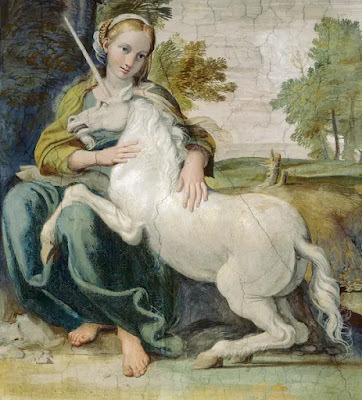
To jog your memory: This is a female Ghost who is too ashamed to be seen in Heaven by the Bright Ones. She is ashamed of appearing ghost-like, i.e. phantasmal or intangible. She fears how the Bright Ones will react to her appearance. A herd of unicorn tries to persuade her to stop focusing on her looks, which is a ridiculous distraction in Heaven. The observers call on the herd to stampede to help knock the lady out of her endless mental loop of self-absorption about appearance.

To jog your memory: This is the ghost hounded by uncontrollable lust. The lizard on his shoulder is the manifestation of the lust. He understands that the lizard can't accompany him to heaven, but he can't give it up ... or can he?
Bonus Question: St. Teresa of Avila in The Interior Castle also describes sins, like those afflicting the ghost, as reptiles. The "reptiles" prowl about the outside of the castle and sometimes intrude into the outer courts. What do you think this means?

#8 The Great Divorce, Discussion Questions - George MacDonald, the Protagonist Maybe the biggest question after reading this book: Does George end up in Heaven or Hell? Or is something else happening? What is the "siren howling overhead"?
January 20, 2025
Novena to Our Lady of Guadalupe, Prayers for Healing, Safety, Protection, & the New 8 Million Conversions
We have often heard the story of Our Lady of Guadalupe's apparitions to St. Juan Diego and his ordeal with the bishop. We do not often hear about the litany of miracles that occurred (and continue to occur) following the apparition of Our Lady of Guadalupe.
This Novena will focus our attention on the miracles that occurred in the wake of the great miracle of the image of Our Lady appearing on St. Juan Diego's tilma. Join us in praying for more miracles like these, especially for the new 8 million, a new and massive surge of conversions like those that occurred between 1531-1538. Please pray for these as we approach 2031, the 500th Anniversary of Our Lady of Guadalupe.
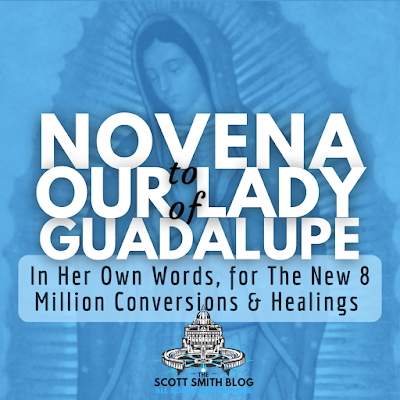
Our Lady of Guadalupe Novena - Table of Contents Table of Contents
When St. Juan Diego was praying for his specific intention, the healing of his mortally sick uncle, the compassionate Virgin answered him as follows, and so let us pray her words. The following is to be recited daily:
Understand, rest very much assured, my youngest child, that nothing whatever should frighten you or worry you. Do not be concerned, do not fear the illness, or any other illness or calamity. Am I, your mother, not here? Are you not under my protective shade, my shadow? Am I not your happiness? Are you not in the security of my lapfold, in my carrying gear? Do you need something more? Do not let anything worry you or upset you further. Do not let [state your intention] worry you ... Rest assured, for [your intention has already been heard].[1]

Also pray the following "Prayer to be Directed to the Heavenly Queen, Our Precious Mother of Guadalupe":
REJOICE, heavenly Queen , eternally blessed Virgin, O merciful one, rejoice, you who are the precious daughter of God the Father. Rejoice, you who are the precious mother of God's precious child. Rejoice, you who are the precious spouse of God the Holy Spirit. It is you we praise, you who have descended from heaven and by a very great miracle have come to reveal yourself to the poor humble commoners. To you we cry, you who are our precious revered mother of Guadalupe, you who in your very great compassion gave us your image, before which we wretches who live in pain on your precious child's earth cry out. Turn your eyes toward us here; may we not disgust you with all our sins. Rather, keep your word to help us and favor us in our difficulties. May we attain your light in order to see the life in heaven. And for your sake may we be pardoned all our sins and offenses against our Lord. May you appease the heart of your precious child; may all his wrath and anger subside. May you take pity on us who are his creatures, who are under your protective shade, who cry out to you today. And then at the time of our death please remove and put to flight our foe, who leads us astray, so that happily and peacefully our souls may go to lie entirely in your hands, so that they may go appear in the presence of God, their creator. Amen. JESUS.[2]
Our Lady of Guadalupe Novena Prayer - Day 1The first miracle wrought by Our Lady of Guadalupe, the roses given to St. Juan Diego, point to one of her greatest and most long-lasting miracles. Listen to how the roses were described in the original account:
Then Juan Diego climbed the hill. When he reached the top, he was greatly astonished at all the different kinds of precious Spanish flowers that were growing there, blossoming and blooming, although their blooming time had not yet come, for it was right then that the frost was strong. They were very fragrant, and the night dew on them was like precious pearls. He thereupon began to pick them; he gathered every one and put them in his lapfold. But the top of the hill was absolutely no place for any flowers to grow, for it was a place of crags, thorns, brambles, cactus, and mesquite, and if some little grassy weeds should grow there at that time, in the month of December, the frost would devour and destroy them all. Then he came back down, bringing to the heavenly Lady the various kinds of flowers that he had gone to pick.[3]
The roses were growing in an inhospitable location: "absolutely no place for any flowers to grow". The place, like in Jesus' Parable of the Sower was choked with "crags, thorns, brambles, cactus, and mesquite." The place was also cold and covered in frost, which would "devour" "little grassy weeds", let alone roses. In this inhospitable place was growing an entire garden of "all the different kinds of precious Spanish flowers." They were not even flowers from Mexico. The origin of the flowers pointed back to Europe.
Why? Because all these flowers, growing here in this rocky place, instead of Spain, point to the Mexican people, themselves. The flowers point to the 8 million conversions that would occur in the 8 years following the appearance of Our Lady of Guadalupe. While all this was happening in Mexico, the Church, the Blessed Mother's own family, was being torn apart in Europe by the Protestant Revolution. Our Blessed Mother insured the future of the Church by sparking a number of Catholic conversions equal to the number of Protestant conversions in Europe.
Mary had told St. Juan Diego "Are you not in the security of my lapfold?" Now, she has St. Juan Diego carefully place these flowers -- these souls to be converted -- into his own lapfold: "As he came he exercised great care with what he had in his lapfold, lest he drop anything, and he enjoyed the fragrance of the various kinds of precious flowers."[4]
Let us pray now to prepare another great bouquet of souls for our Blessed Mother. Let us pray now for more conversions of souls to the Catholic Church, to the lapfold of the Blessed Virgin Mary and to her womb, where souls will find Jesus. We pray for a new, massive round of conversions, the new 8 million, a new massive harvest of flowers. We also pray for all those specific individuals we know [state them by name] that are "ripe flowers" to be picked and placed into the lapfold of Our Lady. We pray for the courage to speak the words of conversion, if such is our role, or for that the words would be given to another, through the Holy Spirit.
Now, recite the daily prayers for this novena.
Our Lady of Guadalupe Novena Prayer - Day 2For the remaining days of this Novena, we will reflect on the first recorded miracles attributed to Our Lady of Guadalupe.
THE VERY FIRST of the miracles that she worked was when they took her to Tepeyacac for the first time after her temple was finished. For at this time the procession in which they took her was performed in the grand fashion. All the priests that there were, and the various Spaniards in whose hands the city was, and also all the Mexica rulers and nobles, came out together, as well as the people from other altepetls all around. Great preparations were made so that things would be well adorned all along the causeway which leaves Mexico as far as Tepeyacac, where the temple of the heavenly Lady had been erected. There were many things for amusement and celebration along the way. The causeway was full of moving people, and since the water of the lake was still very deep on both sides, numerous commoners went by boat; some went along skirmishing, encountering one another in battle. One of the archers who were dressed like Chichimeca drew his bow quite taut, and without warning the arrow flew off and hit one of those who were engaged in skirmishing there; it passed through his neck, and he fell. When they saw that he had died, they took him to the consummate Virgin our Queen; they went and laid him before her. His relatives cried out to her to deign to revive him. And after they pulled the arrow out of him, she not only revived him and gave him life, but he was also immediately healed where the arrow had passed through; all that remained were marks where the arrow entered and came out. Right away he stood up and left; the heavenly Lady sent him on his way, making him joyful. Absolutely everyone marveled greatly and praised the consummate Virgin, the heavenly Lady, Saint Mary of Guadalupe, for the way she was now carrying out the pledge she made to Juan Diego that she would always help and defend the local people and all those who invoked her. It is said that from that moment on this humble person remained at the precious home of the heavenly precious Lady; there he used to sweep her temple and home for her.[5]
We pray today for Our Lady of Guadalupe to be known through miraculous healings and for her to heal miraculously, and even resurrect, those whose names we submit to her intercession.
Our Lady of Guadalupe Novena Prayer - Day 3Today, we read about how the intercession of Our Lady of Guadalupe ended an epidemic in 1544:
WHEN THERE WAS a great epidemic in the year 1544, with very severe loss in the great altepetls, each day a hundred people were being buried; in truth, it exceeded that. When our Lord's precious ones, the friars of Saint Francis, had seen that it was not subsiding, that nothing at all was helping, that no progress could be made, that our Lord the giver of life was reducing and depopulating the land, they arranged a procession to go to Tepeyacac. The precious friars gathered a great many children, female and male, who had just reached the age of six or seven; they went along flogging themselves. As to how the procession went, it came out of the church at Tlatelolco; all along the way, they went crying to our Lord to have pity on his altepetl, that there be an end to his ire and wrath, in the very name and for the sake of his precious, revered mother, the consummate Virgin, our Queen, Saint Mary of Guadalupe of Tepeyacac. As soon as they arrived at her churchly home, the friars offered very many prayers. And God the giver of life willed that through the intercession and prayers of the compassionate personage, his precious, revered mother, the epidemic would begin to subside. The next days not many people were being buried any longer, and finally perhaps two or three people as the epidemic came to an end.[6]
We pray today for the end of epidemics and for healings worldwide. We also pray for the miraculous healing of those whose names we submit to Our Lady's intercession. We pray that these healings will lead to the conversions of hearts and souls to Jesus and His Catholic Church.
Our Lady of Guadalupe Novena Prayer - Day 4Today, we read about the widespread end of idolatry that occurred after the apparition of Our Lady of Guadalupe and the Remedios, an associated image of Our Lady that was given to Don Juan at Totoltepec.
IN THE BEGINNING, when the Christian faith had just arrived here in the land that today is called New Spain, in many ways the heavenly Lady, the consummate Virgin Saint Mary, cherished, aided, and defended the local people so that they might entirely give themselves and adhere to the faith. As a result they despised and abhorred the idolatry in which they had been wandering about in confusion on the earth, in the night and darkness in which the demon had made them live. In order that they might invoke her fervently and trust in her fully, she saw fit to reveal herself for the first time to two people here. They attained the precious images of the consummate Virgin, our Queen, which are here near the altepetl of Mexico; she appeared to Juan Diego at Tepeyacac Guadalupe, and she revealed the image that is called Remedios to don Juan at Totoltepec.
She revealed herself to him [don Juan] on top of a hill, among maguey plants, where her temple stands today. He took her to his home and kept her there for several years, and afterwards he outfitted a small temple for her in front of his house and moved her there. And when she had been there for some time, don Juan contracted a serious illness. When it was seen that he was fatally ill, that he would no longer be able to escape or to get up, he asked his children, the humble Totoltepec commoners, to take him to Tepeyacac where the consummate Virgin, our precious mother of Guadalupe, is, which is perhaps more than two leagues distant from Totoltepec, because he knew how the heavenly Lady had healed Juan Bernardino, resident of Quauhtitlan and uncle of Juan Diego, upon whom a very great illness had likewise come, and had worked all the [other] miracles. Thereupon they laid him on a litter, took him to Tepeyacac, and went to lay him down before the heavenly Lady, our precious mother of Guadalupe. Then he prayed to her tearfully, he bowed down and humbled himself before her, and asked her to do him the favor of healing his earthly body. Perhaps she would cause him to live for another brief day on her earth, so that he could serve her and her precious child. The compassionate one received his prayers benevolently. She was very happy, she smiled when she saw him, and she showed him affection, as she told him, "Get up! you have already been cured. Return to your home. And I command you that on top of the hill, where the maguey plants stand, where you saw my image, you build a small temple, where it will be." And she commanded him to do various other things. At that very moment he recovered. And when he had addressed her with many thanks for her benevolence, he returned home on foot. They no longer carried him in their arms. When he arrived, he immediately carried it out; he built the small temple for the precious image of the heavenly Lady, called Remedios, where she is now. After her temple was finished, she herself entered, all by herself she went to stand on the altar as she is today and as she is depicted in all her miracles.[7]
We pray today for the all images of Our Lady and Our Lady of Guadalupe, particularly, to bring healings and conversions and greater devotion to Jesus through Mary. We also pray for the miraculous healing of those whose names we submit to Our Lady's intercession. We pray that these healings will lead to the conversions of hearts and souls to Jesus and His Catholic Church.
Our Lady of Guadalupe Novena Prayer - Day 5Today, we read about a miraculous rescue from a rampaging horse that occurred through Our Lady of Guadalupe's intercession.
HERE IN THE altepetl of Mexico one of the Spanish noblemen, named don Antonio Carvajal, took a young fellow, a relative of his, with him when he went to Tulancingo. When they passed through Tepeyacac, they first went into the churchly home of the consummate Virgin, our precious mother of Guadalupe; they stopped a while to pray there, they stopped by to greet the heavenly Queen so that she might aid and defend them and cause them to arrive safely where they were going. When they had come back out and were traveling along, on the way they went along talking with one another about the consummate Virgin, how she revealed her precious image by a very great miracle, and how she had worked all the different kinds of miracles, by which she did good to those who invoked her.
As the horse on which the young fellow was riding was going along the road, somehow it fell down; as a result it went wild, or perhaps something frightened it. It took off with great impetus and ran through ravines, past precipices and crags, while he tried with all his strength to pull on the reins. He was unable to control it; it ran him for perhaps half a league. His companions tried to intercept it, but they could by no means do so; it went as if carried by the wind. Then they lost sight of it, and thought that it might have pulverized him somewhere. Indeed it was a very dangerous place that it was heading straight toward, a place of many ravines and crags. But our Lord and the perfectly compassionate one, his precious, honored mother, saw fit to free him.
When they found him, what they came upon was that the horse had stopped, it had bowed its head, and its legs were as though bent. It was entirely unable to move, and the young fellow was stuck in a stirrup, hanging by one foot. When they saw him, they greatly marveled in their hearts; there was nothing at all wrong with him, nor was he hurt anywhere. Thereupon they took him in their arms and released his foot. When he got up, they asked him how he had escaped without anything happening to him, and he said to them, You saw how when we left Mexico, we passed by the home of the heavenly Lady, our precious mother of Guadalupe. Before leaving we marveled at her precious image and prayed to her, and afterwards on the road we went along talking to one another about all the miracles that she has worked and how her precious image appeared by a very great miracle. Absolutely everything found its way into my memory, I took it very much to heart. So when I saw that I was put in great danger, that there was no way I could escape, that I would soon die and perish, that there was no longer any help for me whatever, just at that very moment with all my heart I called on the consummate Virgin, the heavenly Lady, our precious mother of Guadalupe, to have pity on me and help me. Just at that very moment I saw her, just as she herself appears in the precious image of our Queen of Guadalupe. She helped and rescued me; she grabbed the horse's reins, so that it stopped immediately and obeyed her. Like one bowing before her, it knelt down as it was when you found it. They praised the heavenly Lady very greatly, and thereupon they traveled on.[8]
We pray specifically today for the safety of all those that are traveling. More broadly speaking, we pray for Our Lady of Guadalupe to protect us, our loved ones, our specific intentions, and the Church founded by her Son. We pray that this miraculous protection will lead to the conversions of hearts and souls to Jesus and His Catholic Church.
Our Lady of Guadalupe Novena Prayer - Day 6Today, we read about a man saved from a mortal blow by a falling lamp:
ONCE A SPANIARD was kneeling before the heavenly Lady, our precious mother of Guadalupe, praying to her. It happened that the rope broke from which a large lamp was hanging; it was very heavy, and it was hanging in front of her. Right away it went straight toward his head, it fell right on his skull. All those who were there believed that he had died immediately or that it had smashed his head, or that perhaps it had seriously injured him, for it fell from a great height. But not only was he not harmed and suffered no injury of any sort, but the lamp was not crushed anywhere at all, nor was it damaged in the slightest. The glass did not break, the oil that was in it did not spill, and the flame that was burning did not go out. Everyone was very greatly astonished at all the miracles that the heavenly Lady worked at a single time.[9]
We pray specifically today for the safety of all those in the face of unknown dangers and disorders of the brain, whether mental or physical. More broadly speaking, we pray for Our Lady of Guadalupe to protect from harm all of us, our loved ones, our specific intentions, and the Church founded by her Son. We pray that this miraculous protection will lead to the conversions of hearts and souls to Jesus and His Catholic Church.
Our Lady of Guadalupe Novena Prayer - Day 7Today, we read about Father Juan Vasquez de Acuna who was celebrating Holy Mass when suddenly all the candles were blown out:
LICENCIATE JUAN Vasquez de Acuna, former vicar, was in charge there for very many years. Once it happened that he was about to say mass at the main altar and all the candles went out. The sacristan meanwhile went away to light [others], because it was very windy there, and the priest was waiting for the candles to be burning. He saw two things like tassels of flame or lightning come out of the rays of the heavenly Lady and come to light the candles on both sides. This miracle very much astonished all those who were there in her churchly home.[10]
We pray today that the flame of faith would keep burning across the world and, instead of being snuffed out, would spread across the world. We pray for faith to catch fire, especially in the places where it is most unlikely or seemingly impossible. We pray that this spreading flame will lead to the conversions of hearts and souls to Jesus and His Catholic Church.
Our Lady of Guadalupe Novena Prayer - Day 8Today, we read about the miraculous spring that flowed out from behind the Basilica of Our Lady of Guadalupe and the miracles that sprang from it:
WHEN FOR THE very first time the heavenly Lady showed herself to Juan Diego and her precious image very miraculously appeared, she worked very many miracles. It is said that also at that time the spring opened up which is behind the temple of the heavenly Lady to the east, in the very place where she went to meet Juan Diego when he had gone around the hill so that the heavenly Lady might not see him, since he first wanted to call a friar to hear the confession of and prepare his uncle, Juan Bernardino, who lay very gravely ill. It was right there that she intercepted him and sent him to go cut flowers on the top of the hill. It was also where she showed him the level ground where the temple was to be built, and where she sent him for the last time to see the lord bishop, to whom she sent flowers as a proof and sign of her wish that her temple was to be built. All of this was said earlier in passing. Where this water gushes out, although it flies up as it gushes and bubbles, it still does not overflow, nor does it [fly out greatly, only a very little. It is very clean and fragrant, but not good tasting, somewhat as if acidic. It is effective with all different kinds of illnesses for those who in good faith drink it or bathe in it. For that reason the miracles that the consummate Virgin, the heavenly Lady, our precious mother Saint Mary of Guadalupe, has worked are innumerable.
THE STOMACH of a Spanish woman, who was a resident here in the altepetl of Mexico, began for no reason4 to swell as if it were hydropic, as if it would burst. The Spanish physicians tried different kinds of medicine by which to cure her; absolutely nothing helped or worked, but it kept on growing all the more. It was now ten months that she had the illness, and she was quite certain that she could never get well again, that she would die of it, unless the heavenly Lady, the consummate Virgin, Saint Mary of Guadalupe, would heal her. She directed them to carry her on a litter and take her to Tepeyacac to the home of the heavenly Lady. Very early in the morning they started her on her way, and when they got her to her churchly home, they laid her down before her. Thereupon she prayed to her with all her heart that she would have pity on her and cure her. She wept before her, prostrated herself, and asked to be given a little bit of her spring water to drink. After she drank it, her body temperature moderated, and she fell asleep. When it was past midday and the bell was about to strike one, those who had brought her came back outside the building for a while to go look around. They came out leaving her all alone while she slept and her temperature moderated, and one of the humble commoners who had taken a vow there to sweep at the church saw a very frightening snake come out from under her, a fathom and one span in length, and very thick. He was very frightened and immediately cried out to the Spanish woman who was sick. At that she awoke and got up. She was very much startled and frightened and repeatedly cried out to summon someone. Then they killed the snake there; at that very moment she got well and her stomach went down. She spent four more days there, in order to pray daily to the heavenly Lady who had done her this favor and healed her. When she came back, they no longer carried her in their arms; she came back just on foot. Now she came greatly rejoicing; nothing was ailing her any more.[11]
We pray again for the miraculous healing of those whose names we submit to Our Lady's intercession. We pray that these healings will lead to the conversions of hearts and souls to Jesus and His Catholic Church.
Our Lady of Guadalupe Novena Prayer - Day 9Today, we read about the miraculous healing of the head and ears of a Spanish nobleman:
THE HEAD AND ears of a Spanish nobleman, a resident here in the altepetl of Mexico, pained him very badly, as if they would burst; absolutely nothing helped him. He could endure it no longer, and he directed that he be taken to the precious home of the consummate Virgin, our precious mother of Guadalupe. When he arrived in her presence, he prayed to her with all his heart to help him and cure him. He vowed that when she had cured him, he would make an offering to her of a head of silver. Just at the very moment he got there, he was cured. After he had spent nine days at the home of the heavenly Lady, he returned home rejoicing. Absolutely nothing more was ailing him.
We pray specifically today the healing of minds and ears that they may better understand and listen to the Word of God. We pray again for the miraculous healing of those whose names we submit to Our Lady's intercession. We pray that these healings will lead to the conversions of hearts and souls to Jesus and His Catholic Church.
Our Lady of Guadalupe Novena Footnotes[1] The Story of Guadalupe, Luis Laso de la Vega’s Huei tlamahuicoltica of 1649 (Stanford University Press, 1998), 77-79.[2] Ibid., 127.[3] Ibid., 79. [4] Ibid., 81.[5] Ibid., 93-95[6] Ibid., 95-97[7] Ibid., 97-99[8] Ibid., 99-103[9] Ibid., 103-105[10] Ibid., 103-105[11] Ibid., 105-107 mbtTOC();



